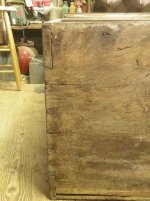Peter Storey Pentz
Well-known member
Because I am a new member, I wander around the Forum reading old posts and trying to catch up. This is a response to the Feb., 2011 postings on dust boards.
Jeff, I believe your high chest is from Chester County, PA. The extension of the sides to support bracket feet is a common feature of that region. Also, a picture of a high chest with an identical drawer behind its bolection molding can be found in Schiffer's book, 'Furniture and Its Makers of Chester County, Pennsylvania', #131. That high chest also has the owner's initials inlaid in the top center drawer as well as the date, 1747.
It is a really nice high chest. PSP
Jeff, I believe your high chest is from Chester County, PA. The extension of the sides to support bracket feet is a common feature of that region. Also, a picture of a high chest with an identical drawer behind its bolection molding can be found in Schiffer's book, 'Furniture and Its Makers of Chester County, Pennsylvania', #131. That high chest also has the owner's initials inlaid in the top center drawer as well as the date, 1747.
It is a really nice high chest. PSP

